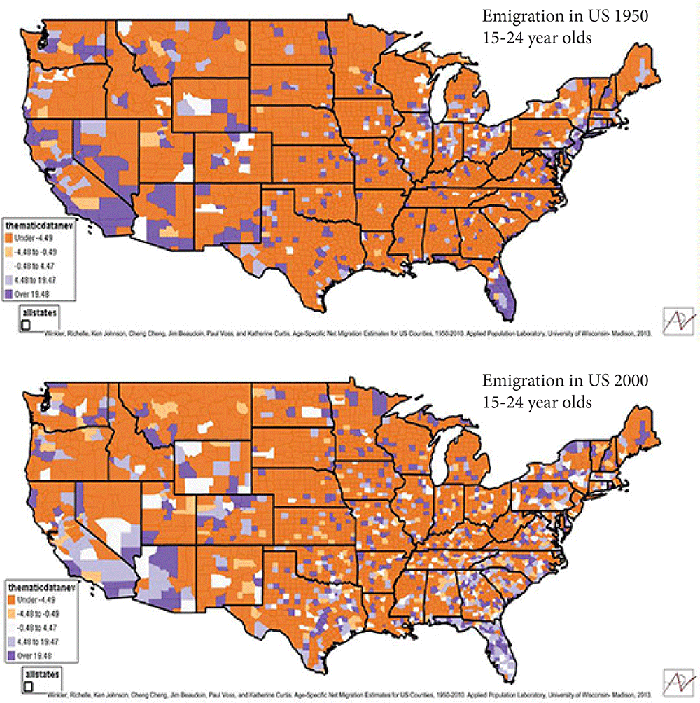One persistent myth in the Adirondack Park population debate is that environmental regulations and the Forest Preserve drive young people out of the Adirondack Park. In certain quarters this is treated as gospel in the debate over the future of the Adirondack Park.
The reality is that this myth is a myth.
A great tool has come out recently from researchers at the University of Wisconsin-Madison, who put together a fascinating interactive website with U.S. population emigration data 1950-2010. It lets one explore various population migration trends across the U.S. post World War II. The UW-Madison site helps us in the Adirondacks see how our demographic trends track closely to the rest of rural America.
Population decline in rural America has been driven by the loss of the rural manufacturing base that could not compete with cheap overseas costs. It’s been driven by the vast mechanization and contraction of the farm and logging work forces. For example, Iowa State University reports the number of hog farmers in Iowa dropped from 65,000 in 1980 to 10,000 in 2002, while the number of hogs per farm increased from 200 to 1,400. It’s been driven by the massive growth of online shopping and services (remember in the days before NetFlix when there were video stores in several Park communities). Government austerity programs don’t help rural areas either as public sector employment is always higher in rural areas as a total percentage of the work force.
As previous PROTECT’s Myths & Reality have shown (see Myths & Reality 1 and Myths and Reality 2)Â many Adirondack school districts graduate students at significantly higher rates than the state average. This produces an out-migration of young people who leave the Adirondacks in high numbers to go to college, or to a lesser extent the military, and then they overwhelmingly start their careers in major or minor metropolitan areas, and not back home in the Adirondacks.
This demographic reality is not unique to the Adirondacks, but has a dominant fact-of-life in rural America for decades. None of this is new. Young people leave rural areas for college. Young people go to metro areas to start their careers.
The out-migration of college-age young people and steady, slow population loss is near universal across the rural America. In the U.S. today, we have the highest percentage of Americans living in major and minor metropolitan areas than at any time before in American history. Though 72% of the American landscape is classified as “rural” it is now home to just 15% of the American population. In 2012, the US Census reported that 80% of rural counties in the U.S. lost population. In 1910, 72% of Americans lived in rural areas.
Today, the greatest percent of jobs – over 88% – are located in major and minor metropolitan areas than ever before in American history. The jobs percentage in metro areas is even greater than the population percentage, which means that plenty of Americans commute from rural areas to metro areas for employment.  In fact, the rural-metro jobs gap is growing: over the past year rural areas lost a net of 149,000 jobs while metro areas gained a net of 175,000.
Here’s how the Brookings Institute put it in 2011:
Metropolitan areas nationwide boast disproportionate shares of the assets that will drive the next wave of U.S. economic growth. With 84 percent of the nation’s population, all 366 metropolitan areas together produce 85 percent of U.S. exports, and are home to 86 percent of its lower-carbon commuters (those not driving alone to work), 89 percent of working-age people with a post-secondary degree, and 93 percent of individuals employed in science and engineering occupations.
The UW-Madison website shows that the demographic realities of rural America are the demographic realities of the Adirondack Park. There is little unique about the Adirondack population. Like the rest of rural America we have a stagnant or declining population. Like the rest of rural America we are overwhelmingly white. Like the rest of rural America our overwhelming white population is aging rapidly (80% of Americans over 65 years old are white). Like the rest of rural America we see an out-migration of college-age young people. Like the rest of rural America we see a slow in-migration starting around 35 years old.
The Adirondacks has some slight variations to these national trends in two ways. First, the overall population declines in the Adirondacks have been minor; some Adirondack counties have even bucked the national trends altogether since WWII and showed a net positive population gain. In fact, the Park’s overall population is up 30% 1950-2010. Second, in the Adirondacks we see an uptick in migrants of retirement age moving here, starting around 55 years old.
The UW-Madison database drives these points home about major national trends. The first two maps made from this site show emigration rates for 15-24 year olds in the U.S. at the county level in 1950 and 2000.
The sea of counties with out-migration (brownish-orange) are overwhelmingly rural. The differences between the metro areas and rural areas are stark for young people. Metro areas gain, rural areas lose. These maps have a great deal of overlap in the sheer amount of counties that experienced an out-migration of young people.
Out-migration of 15-24 year olds is not something new. It has been a steady fact in rural America for the last 50 years.
The next three series of charts compare migration rates by age and show long-term trends since the 1950s for population migration in the U.S. Again, these patterns are not new, but show great uniformity over the past 50 years with minor variations. Note two things. First, rural areas see a significant out-migration rate starting with the 15-19 age cohort (heavily influenced by young people who leave for college at age 18), while metro areas experience great in-migration rate of young people. Second, metro areas continue to see positive migration rates of young people after college in the 20-24 and 25-29 age cohorts. College graduates overwhelmingly move to metro areas.
For the three metro areas I selected the counties around New York, Boston and Los Angeles. But, you can go to the UW-Madison website and pick a county around almost any major metro area county and the result is the same as in New York City, Boston or Los Angeles. Most metro areas in the U.S. are growing and attractive to post-college young people. Not all these places were growing in 1950, but the vast majority of them are growing in 2010. Rural areas are not growing.
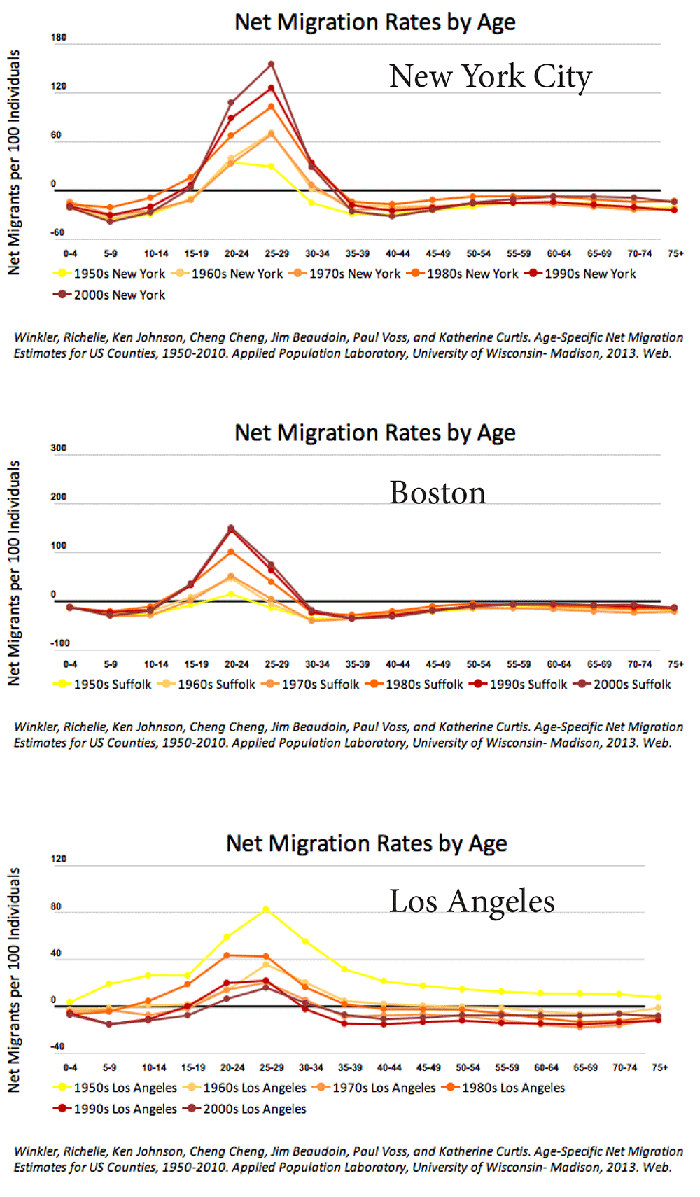
Charts of three metro area counties that show positive emigration rates for college-age and post-college-age people.
There are some notable exceptions, like Wayne County in Michigan, home of the city of Detroit, which functions much like a rural county for out-migration rates, and other places like Buffalo, which functioned much like a metro county in the 1950s and 1960s, but since looks much like a rural county.
For the rural counties I provide three sets of long-term migration rate charts: 1) three Adirondack counties – Hamilton, Essex, and Warren; 2) three Upstate New York counties – Tioga, Steuben, and Columbia; 3) three rural America counties – Holt County in Nebraska, St. Francis County in Arkansas, and Calhoun County in Iowa.
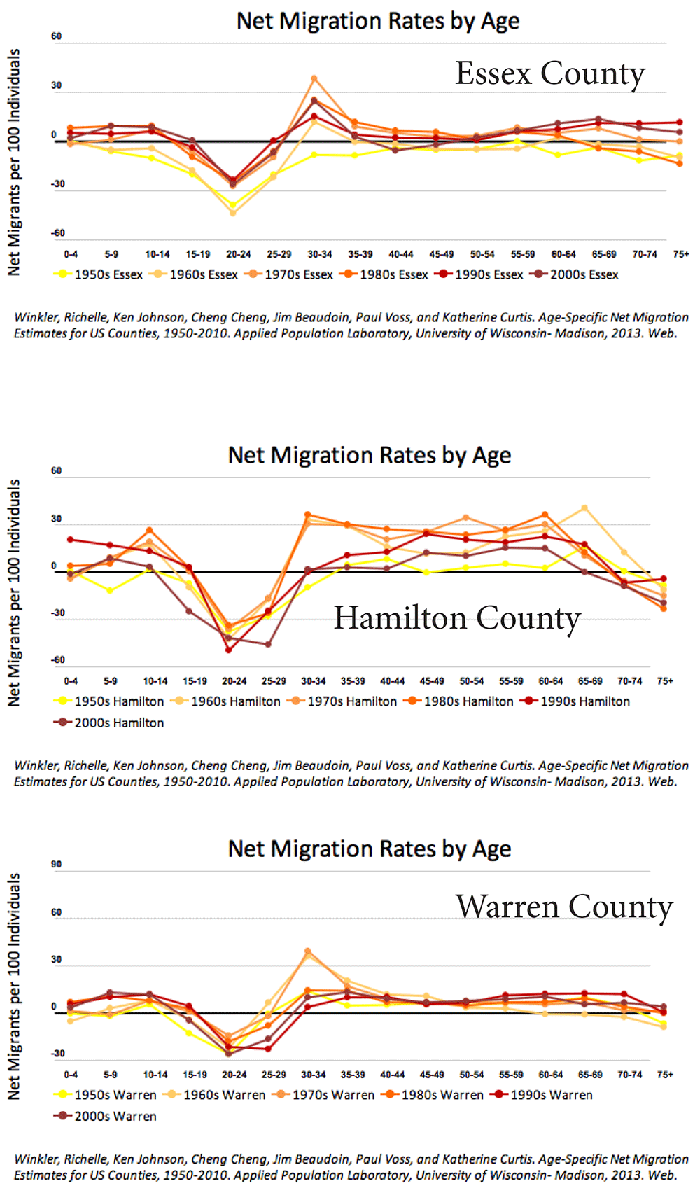
Charts of three Adirondack Park counties that show negative emigration rates for college-age and post-college-age people.
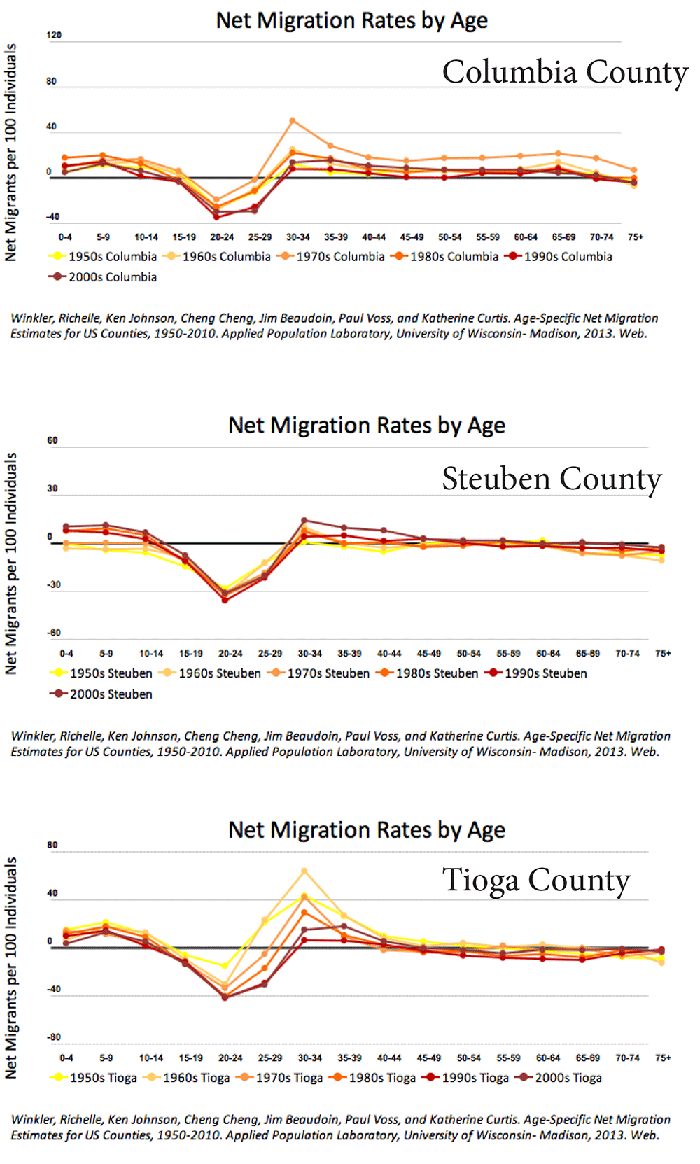
Charts of three Upstate New York rural counties that show negative emigration rates for college-age and post-college-age people.
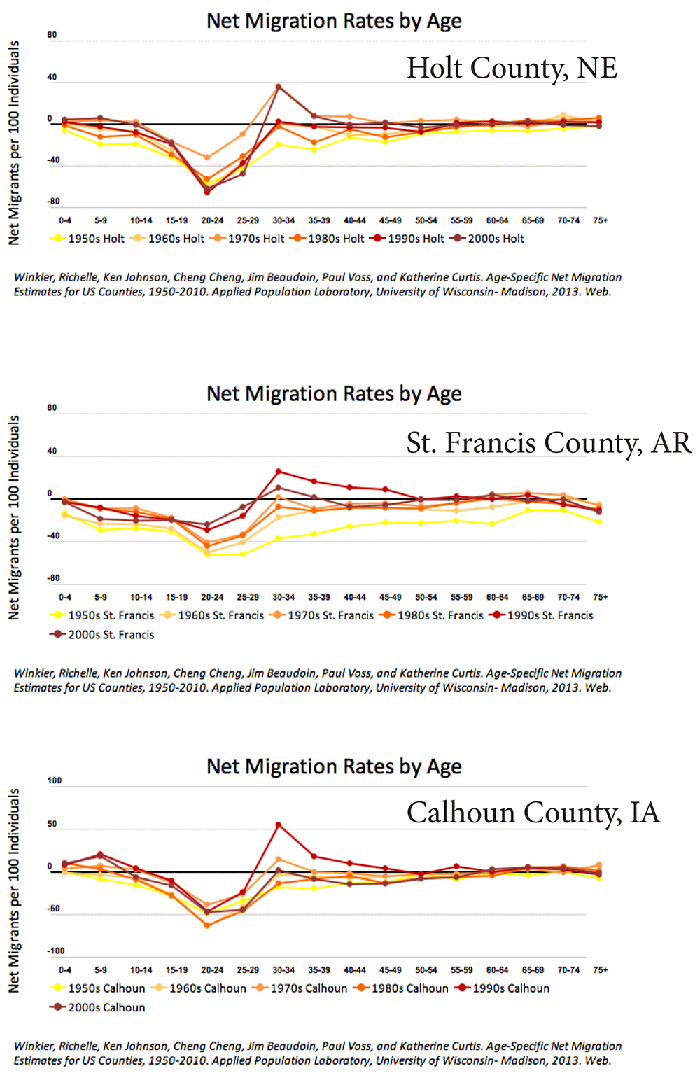
Charts of three rural U.S. counties that show negative emigration rates for college-age and post-college-age people.
The rural counties all show negative migration for 15-25 year olds, but experience positive migration starting around 30. There are also not a lot of people moving to metro areas in their 30s, but this is a time when some people will make the move to a rural area for a lifestyle or career change. Note too that these trends are remarkably similar over the past 50 years.
Go to the UW-Madison website and pick a rural county and the results are similar to Hamilton, Essex and Warren counties in the Adirondacks or Steuben, Tioga or Columbia counties in Upstate New York or to Holt, St. Francis or Calhoun counties. That said, in the Adirondacks you’ll see variations on the theme in Franklin County, largely due to significant population growth in the last thirty years among the Native American population, and in Clinton and St. Lawrence counties due to colleges.
One thing to note that is unique to the Adirondacks is that there’s a positive migration uptick that starts around age 55. Many other rural counties don’t see retirees moving in. This is an asset and a positive for Adirondack communities.
The flip side of the demographic trends for rural America depicted in the charts above is that the metro areas in the U.S. that are experiencing population growth are also those places with high minority population gains. Not only are they attracting white college graduates from rural areas, but they are seeing enormous populations gains from minority births and international immigration. In 2012, the US Census reported that half of American births were minorities, who are overwhelmingly located in major and minor metro areas. Contrast this trend with the fact that 80% of Americans age 65 and older is white.
The demographic reality for rural America in 2014 is that its population will continue to shrink for some time to come. There are demographic factors that will accelerate this trend, such as the rapid aging of America’s white population, which is the population of rural America. 10,000 baby boomers turn 65 every day in the U.S. and that trend will continue until 2030. Rural areas like the Adirondacks, that are monolithically white populations, will see their median age continue to rise for years to come.
What this all shows is that when it comes to population and demographics the Adirondack Park is not unique. To somehow isolate environmental controls or the Forest Preserve as the causes of out-migration of young people doesn’t add up. It denies 50-year trends in rural America. The population and demographic realities of the Adirondacks are perfectly consistent with the trends for rural America.
The dominant political rhetoric of ADK Works, the APRAP report, or the Adirondack Futures project is that the Forest Preserve and environmental controls have constrained and harmed the Adirondack Park’s population and demographics. This narrative is politically charged and backed by no data, cherry picking data, or analyzing the Adirondack Park in a vacuum with no comparisons to other rural areas in the U.S.
The Adirondack Park needs an accurate assessment of its demographic reality. Adirondack Park communities are not well served by misdiagnosing our demographic challenges.
Based on national trends for rural America, the Adirondack Park’s population will continue to stagnate or mildly drop as our predominantly white population continues to age over the next 20-30 years. That the Park’s future may mean a stagnant or smaller population, doesn’t make it a worse future.
It’s refreshing to get a tool like the UW-Madison website to try and bring some reality to the debate over Adirondack Park population trends.
This post also was published on the Adirondack Almanack.

